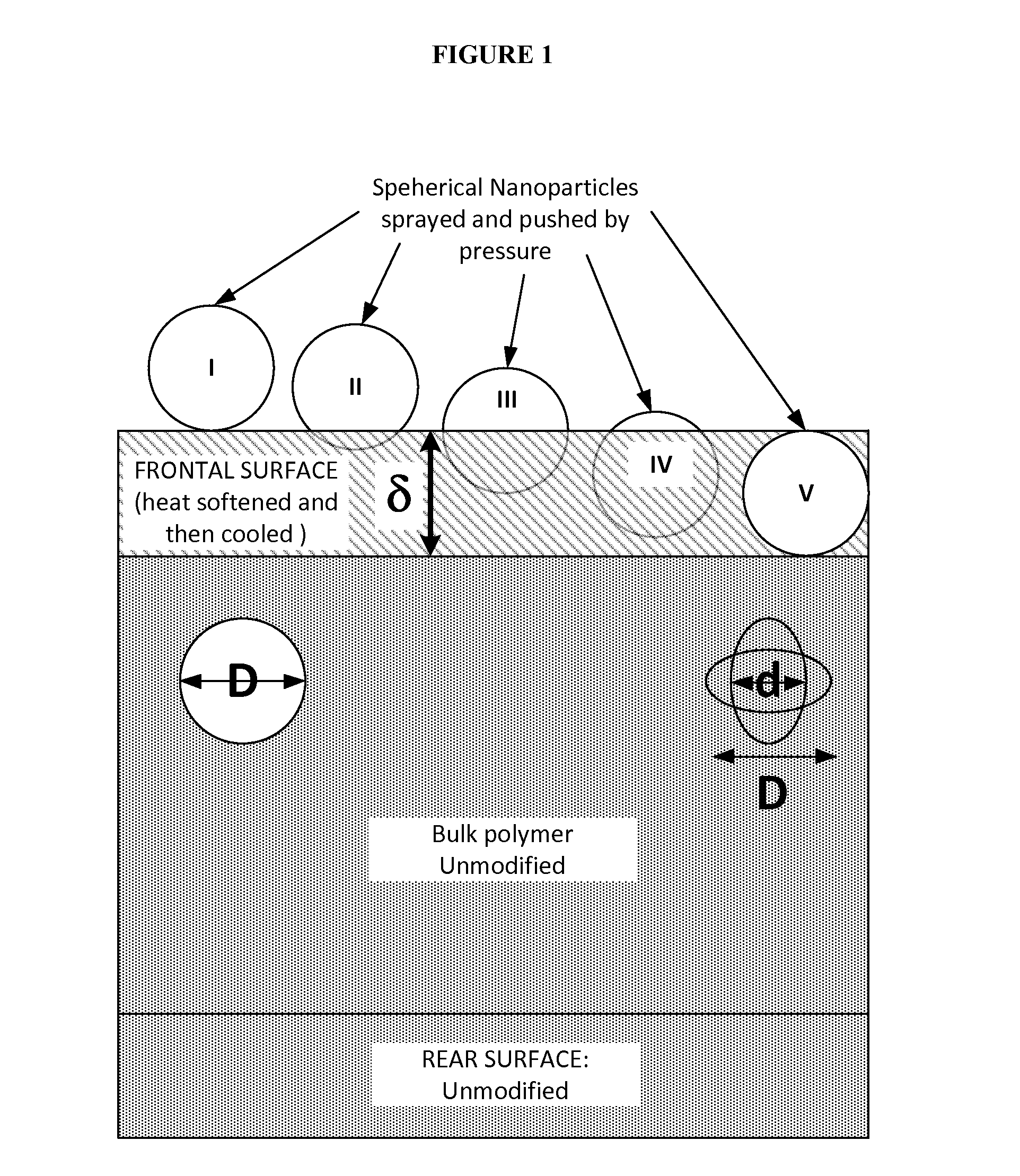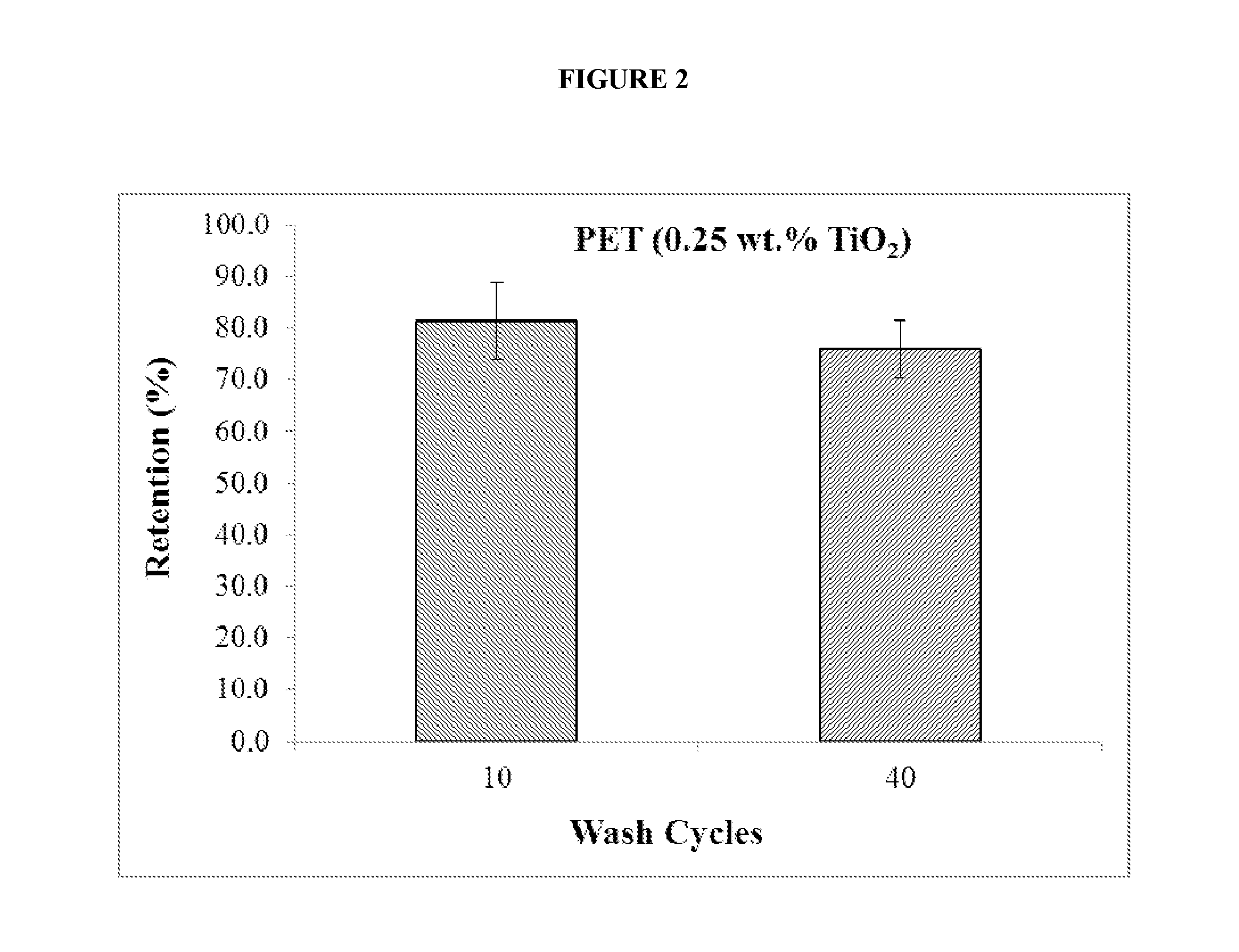Embedding nanoparticles in thermoplastic polymers
- Summary
- Abstract
- Description
- Claims
- Application Information
AI Technical Summary
Benefits of technology
Problems solved by technology
Method used
Image
Examples
example 1
Producing a Nanoparticle-Embedded Polymeric Textile
[0107]a. with Chemical Pre-Treatment Followed by Manual Spraying, Heating and Pressing
[0108]A thermoplastic polymeric fabric material (polyester fabric) was pre-treated with hydrogen peroxide on a single side of the material. The material was then positioned and clamped to a metal board. This set-up was then placed in a hot plate apparatus within a protective chamber (see FIG. 4). Heat was applied to a top plate positioned horizontally to the pre-treated side of the fabric.
[0109]A spray-nozzle containing a TiO2 nanoparticle suspension was positioned approximately 150 mm from the fabric surface and operated for 1 second in a right to left direction. Immediately after spraying, the hot plate was pressed onto the treated fabric for two minutes. The material was then placed in a sealed container. The preferred processing parameters were as follows:[0110]Volume of spray-nozzle container—25 ml[0111]Solution concentration—4.4 wt. % TiO2 in...
example 2
Photosterilization of Polymeric Textiles with Manually Embedded Nanoparticles
[0135]TiO2 and Ag—TiO2 were embedded in PET fabrics following the schema in FIG. 1, but using the manual process as described in Example 1a.
[0136]TiO2 doped materials exhibit significant absorption band in UV spectral region, with maximum absorption at 360-390 nm. After illumination of TiO2-polymeric materials by UV light (365 nm), significant and strong photocatalytic properties can be observed. Moreover, nano-TiO2 materials doped by Ag exhibit antimicrobial properties after illumination by light with wavelength around 415-430 nm. This kind of nanomaterial exhibits antimicrobial activity and can be used to prepare various textiles, which can be able to sterilized themselves after UV and violet light illumination.
[0137]This example shows that antimicrobial activity can be achieved by using UV bulb lamps with the emission maximum at 365 nm. In another words, it is possible to perform photo-sterilization of ...
example 3
Effect of Temperature on the Bonding of TiO2 Nanoparticles in PET
[0142]This example illustrates the effect of hot-plate temperature on the bonding strength of nanoparticles to the polymeric material. PET was used as a the polymeric material, with a nanoparticle concentration of 0.25 wt. % nanoparticles sprayed. Nanoparticles were measured as percentage retention by characterization techniques. Polymeric materials were measured for nanoparticle retention after 10 and 40 washing cycles of a domestic laundering machine (including a pre-wash cycle to remove loose nanoparticles), in accordance with BS EN ISO 6330-2000. Hot-plate temperature embedding at 190° C. displays the highest retention of nanoparticles. Nanoparticle retention decreases as the hot-plate temperature decreases. The increase in laundering cycles from 10 to 40 also highlights the positive effect that increasing hot-plate temperature has on nanoparticle retention (FIGS. 24-25).
[0143]TiO2 nanoparticles of Degussa Aerosil ...
PUM
| Property | Measurement | Unit |
|---|---|---|
| Thickness | aaaaa | aaaaa |
| Pressure | aaaaa | aaaaa |
| Diameter | aaaaa | aaaaa |
Abstract
Description
Claims
Application Information
 Login to View More
Login to View More - R&D
- Intellectual Property
- Life Sciences
- Materials
- Tech Scout
- Unparalleled Data Quality
- Higher Quality Content
- 60% Fewer Hallucinations
Browse by: Latest US Patents, China's latest patents, Technical Efficacy Thesaurus, Application Domain, Technology Topic, Popular Technical Reports.
© 2025 PatSnap. All rights reserved.Legal|Privacy policy|Modern Slavery Act Transparency Statement|Sitemap|About US| Contact US: help@patsnap.com



